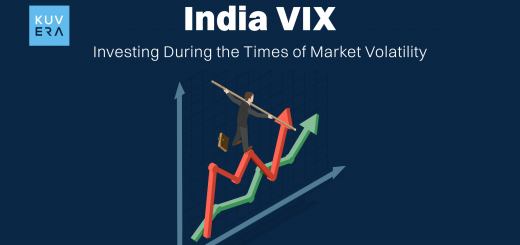This article explains all you need to know about mid cap stocks, their advantages, risks and role in a diversified portfolio. Also, learn about midcap indices – the various indices that track the performance of midcap stocks and the top mutual funds schemes based on these indices.
What Are Midcap Stocks?
Midcap stocks are shares of those companies whose market capitalisation is between ₹5,000 crore to ₹20,000 crore. They are classified based on free-float market capitalisation and are stocks that rank from 101 to 250. These companies have a medium market capitalisation that falls between largecap and smallcap stocks. Investing in midcap companies is usually considered comparatively riskier than largecap companies because they tend to be more volatile. Midcap stocks are often characterised by higher growth potential than largecap stocks, as these companies have room for expansion and can deliver higher growth than largecap stocks or blue-chip stocks.
Here is a table to help you understand the difference between midcap stocks and other stocks:
| Largecap Stocks | Midcap Stocks | Smallcap stocks |
| Stocks of companies with a market capitalisation of more than ₹20,000 crore | Stocks of companies with a market capitalisation between ₹5000 crore and ₹20,000 crore | Stocks of companies with a market capitalisation of more than ₹20,000 crore |
Note- A company’s rank in benchmark indices like the Sensex and Nifty also affects its classification. For example, the companies listed in the Nifty Index between the 101st and the 250th rank are typically categorised as mid-cap corporations. The top 50 most traded mid-cap stocks in the market are included in the Nifty Midcap 50, a benchmark mid-cap index in India maintained by Nifty.
What Are The Features Of Midcap Stocks?
Midcap stocks combine the elements of both smallcap and largecap stocks. Here are the features of midcap stocks:
1/ Diversity: They occupy a middle ground between smallcap and largecap stocks. Midcap stocks offer a wide range of risk and return profiles. Some midcap companies may be in the early stages of development, providing stability rather than high returns, while others could offer significant returns as they transition from smallcap status.
2/ Growth Potential: Midcap stocks are known for their strong growth potential. During bullish market conditions or expansion, midcap companies can experience rapid growth, leading to substantial returns for investors.
3/ Moderate Risk: Compared to smallcap stocks, midcap stocks tend to show lower volatility in response to market fluctuations. However, they may offer less stability during market contractions compared to largecap stocks. This balanced risk profile makes them attractive to investors looking for growth opportunities with moderate risk exposure.
4/ Liquidity: Midcap stocks are relatively more liquid, making them easier to buy and sell compared to smallcap stocks. Investors are more familiar with midcap companies, which improves trust and helps with trading at fair market prices.
What Are The Benefits Of Investing In Midcap Stocks?
Here are some of the key advantages of investing in midcap stocks:
1/ Growth Potential: Midcap stocks belong to companies with moderate market capitalisation, which often allows for higher growth potential compared to largecap stocks.
2/ Diversification: Midcap stocks provide diversification benefits to an investment portfolio. They offer a balance between smallcap and largecap stocks, varying in terms of risk and returns. Including midcap stocks in a portfolio can help spread risk across different market segments, thus reducing overall portfolio risk.
3/ Lesser Analysed: Many midcap stocks are not analysed as often in their initial days, resulting in limited attention from large institutions and seasoned investors. This can lead to lower pricing, making it more affordable to include midcap stocks in a portfolio.
4/ Information Availability: Midcap companies provide enough information on their financial health and history, making it easier for investors to analyse their growth potential and profitability.
5/ Moderate Risk: Compared to smallcap stocks, midcap stocks have lower market volatility. While they might not offer the same level of stability as largecap stocks, they generally exhibit lesser volatility during market contractions or bearish markets.
What Are The Risks Associated With Midcap Stocks?
As a midcap investor, you must be mindful of the following things before you start investing:
1/ Value Trap: Some midcap companies, particularly those ranked lower, may fall into a “value trap,” where they consistently operate with low profits and limited cash flow. If a company remains in this phase for an extended period, it may struggle to break out and could eventually become defunct.
2/ Inadequate Resources: Midcap companies may have less efficient managerial and organisational infrastructure compared to largecap companies. While they might generate high profits and attract value appreciation, they might not be equipped to utilise these resources optimally, potentially impacting their long-term sustainability.
3/ Effect of Financial Bubble: Exceptional performance by a midcap company may sometimes be the result of an unstable financial bubble. If a midcap company lacks the financial strength to withstand the bursting of a bubble, it could face significant challenges. Hence, it’s important to assess a company’s financial history.
What Are The Top Mid cap Stocks In India?
Here are the top 15 mid cap stocks based on average market capitalisation on NSE. This data pertains to the categorisation as per SEBI Circular dated Oct 6, 2017.
| Company name | ISIN | BSE Symbol | NSE Symbol | Avg. Market Cap of All Exchanges |
| Cummins India Ltd. | INE298A01020 | CUMMINSIND | CUMMINSIND | ₹82452.90 cr |
| Polycab India Ltd. | INE455K01017 | POLYCAB | POLYCAB | ₹81848.99 cr |
| CG Power and Industrial Solutions Ltd. | INE067A01029 | CGPOWER | CGPOWER | ₹81134.10 cr |
| ICICI Prudential Life Insurance Co. Ltd. | INE726G01019 | ICICIPRULI | ICICIPRULI | ₹80848.81 cr |
| ICICI Lombard General Insurance Co. Ltd. | INE765G01017 | ICICIGI | ICICIGI | ₹80030.57 cr |
| HDFC Asset Management Co. Ltd. | INE127D01025 | HDFCAMC | HDFCAMC | ₹79266.44 cr |
| Indian Hotels Co. Ltd. | INE053A01029 | INDHOTEL | INDHOTEL | ₹79115.85 cr |
| Indian Railway Catering & Tourism Corporation Ltd. | INE335Y01020 | IRCTC | IRCTC | ₹78372.54 cr |
| Max Healthcare Institute Ltd. | INE027H01010 | MAXHEALTH | MAXHEALTH | ₹78001.27 cr |
| Indus Tower Ltd. | INE121J01017 | INDUSTOWER | INDUSTOWER | ₹77059.64 cr |
| Vodafone Idea Ltd. | INE669E01016 | IDEA | IDEA | ₹78513.02 cr |
| Solar Industries India Ltd. | INE343H01029 | SOLARINDS | SOLARINDS | ₹73755.54 cr |
| Info Edge(India) Ltd. | INE663F01024 | NAUKRI | NAUKRI | ₹72880.23 cr |
| Tube Investments of India Ltd. | INE974X01010 | TIINDIA | TIINDIA | ₹72746.31 cr |
| Colgate-Palmolive (India) Ltd. | INE259A01022 | COLPAL | COLPAL | ₹72468.34 cr |
Source: AMFI website as of 30 June 2023.
What Are The Mid Cap Indices?
Midcap indices are stock market indices that track the performance of mid-sized companies. These indices serve as benchmarks for investment products like midcap mutual funds. Some popular midcap indices include the S&P MidCap 400, NASDAQ Mid-Cap 100, and the FTSE 250 Index.
For a new investor looking to get exposure in Midcap stocks, it is advisable to go for index funds that track the midcap indices, as it offers more diversity and lower cost of investing (lower expense ratio) than picking individual stocks.
Start investing in Index Funds.
What Are The Midcap Indices Under BSE and NSE?
The midcap indices under Bombay Stock Exchange (BSE) are as follows:
1/ S&P BSE Mid Cap: It is a stock market index maintained by the BSE that tracks the performance of mid-sized companies listed on the exchange. It serves as a benchmark for the midcap segment of the Indian equity market.
2/ S&P BSE 150 Midcap: It tracks the performance of the 150 largest midcap companies listed on BSE.
3/ S&P BSE 200: It is a broad-based index that tracks the performance of the top 200 companies listed on the BSE.
4/ S&P BSE Midcap Select: It is a market capitalisation-weighted index that tracks the performance of the top 25 midcap companies listed on the BSE. This index provides you with a benchmark to capture the performance of the midcap segment of the Indian stock market.
The midcap indices under NSE are as follows:
1/ Nifty Midcap 50: This index is also designed to track the performance of the midcap segment of the market. It consists of the top 50 companies based on their full market capitalisation from the Nifty Midcap 150 Index, with a preference for stocks on which derivative contracts are available on the National Stock Exchange (NSE). It represents approximately 7.3% of the free float market capitalisation of the stocks listed on the NSE as of March 28, 2024.
2/ Nifty Midcap 100: The midcap index includes a diverse representation of mid-sized companies, offering you the performance of this segment of the market. It is designed to capture the movement of the midcap segment and represents about 12.1% of the free float market capitalisation of the stocks listed on the NSE as of March 28, 2024.
3/ Nifty Midcap 150: It represents the next 150 companies (companies ranked 101-250) based on full market capitalisation from Nifty 500. This index aims to measure the performance of mid-market capitalization companies. It represents about 15.2% of the free float market capitalization of the stocks listed on the NSE as of March 28, 2024. The total traded value for the last six months ending March 2024 of all index constituents is approximately 22.2% of the traded value of all stocks on NSE.
4/ Nifty Midcap Liquid 15: It is designed to provide you with more exposure to the most liquid midcap stocks in the Indian market. This index is computed using the free-float market capitalisation weighted method, making it easily replicable and tradable.
5/ Nifty Midcap Select: It is designed to mirror the performance of a targeted portfolio comprising 25 stocks within the Nifty Midcap 150 index. This index focuses on selecting stocks based on market capitalisation, average daily turnover and their availability for trading on the NSE’s Futures & Options segment (F&O). The weight of each stock in the index is determined by free-float market capitalisation.
6/ Nifty Midcap150 Momentum 50: This NSE index aims to track the performance of the top 50 companies within the Nifty Midcap 150 based on their normalised momentum score*.
7/ Nifty Midcap150 Quality 50: It selects the top 50 companies from the NIFTY Midcap 150 index based on their ‘quality’ scores, which are determined by factors like return on equity, financial leverage and earnings per share (EPS).
*Normalised momentum score (NMS) measures a stock’s price momentum considering its volatility. It is calculated based on the stock’s 6-month and 12-month price returns, adjusted for daily price volatility. A high NMS indicates strong upward momentum, while a low NMS suggests downward momentum. It is used to identify stocks with strong price momentum that may outperform the market.
What Is The Difference Between BSE Mid Cap And Nifty Mid Cap 100?
The BSE Midcap Index tracks the performance of the top 100 midcap companies by market capitalisation listed on the BSE, while the Nifty Midcap 100 Index tracks the top 100 midcap companies on the NSE. The BSE Midcap Index uses the free-float market capitalisation methodology, whereas the Nifty Midcap 100 Index uses the float-adjusted market capitalisation method.
What Are The Top Index Funds Tracking The Nifty Midcap 150?
The top index funds tracking the Nifty Midcap 150 based on their AUMs as of 5 July 2024 are as follows:
| Index Funds | AUM* | 1Y Returns | 3Y Returns |
| Motilal Oswal Nifty Midcap 150 Index Growth Direct Plan | ₹1591 cr | 57.57 | 27.85 |
| Nippon India Nifty Midcap 150 Index Growth Direct Plan | ₹1313 cr | 57.27 | 27.60 |
| SBI Nifty Midcap 150 Index Growth Direct Plan | ₹446 cr | 57.24 | NA |
| ICICI Prudential Nifty Midcap 150 Index Growth Direct Plan | ₹437 cr | 56.95 | NA |
| Aditya Birla Sun Life Nifty Midcap 150 Index Fund | ₹196 cr | 57.83 | 27.88 |
| Navi Nifty Midcap 150 Index Fund | ₹150 cr | 57.05 | NA |
| HDFC NIFTY Midcap 150 Index Fund | ₹147 cr | 56.66 | NA |
*AUM is Assets Under Management
Source: AMFI website as of 5 July 2024.
What Are The Top Mutual Funds Tracking The Nifty Midcap 150?
The top five mutual funds tracking the Nifty Midcap 150 based on 3-year returns as of 5 July 2024 are as follows:
| Mid Cap Funds | AUM | 1Y Returns | 3Y Returns | TER^ |
| Motilal Oswal Midcap Growth Direct Plan | ₹10,378 cr | 67.50% | 40.80% | 0.65% |
| Quant Mid Cap Growth Direct Plan | ₹7,953 cr | 74.22% | 35.22% | 0.62% |
| Nippon India Growth Fund Growth Direct Plan | ₹27,931 cr | 59.81% | 31.32% | 0.81% |
| HDFC Mid Cap Opportunities Growth Direct Plan | ₹65,394 cr | 54.17% | 30.57% | 0.76% |
| Mahindra Manulife Mid Cap Growth Direct Plan | ₹2,580 cr | 67.08% | 30.21% | 1.13% |
^TER is Total Expense Ratio
Source: AMFI website as of 5 July 2024.
What Are The Top Mutual Funds Tracking The BSE 150 Midcap?
The top five mutual funds tracking the BSE 150 Midcap based on 1-year returns as of 5 July 2024 are as follows:
| Mid Cap Funds | AUM* | 1Y Returns | 3Y Returns | TER |
| Invesco India Midcap Fund | ₹4,631 cr | 57.76% | 27.03% | 0.61% |
| WhiteOak Capital Mid Cap Growth Direct Plan | ₹1,869 cr | 55.20% | NA | 0.44% |
| Canara Robeco Mid Cap Growth Direct Plan | ₹2,224 cr | 54.36% | NA | 0.59% |
| Union Midcap Growth Direct Plan | ₹1,183 cr | 50.97% | 25.26% | 0.60% |
| Axis Mid Cap Growth Direct Plan | ₹27,748 cr | 49.11% | 22.93% | 0.53% |
Source: AMFI website as of 5 July 2024.
How Can I Start Investing In Midcap Stocks?
To add mid-cap stocks to your portfolio, you can invest in mutual funds tracking any mid-cap index.
Step 1: Sign up for an account at Kuvera.
Step 2: Click on the “Invest” section on the ‘Explore’ page and select “Mutual Funds”. Choose “Equity” as your category and “Mid Cap Fund” as the sub-category.
Step 3: Review the fund performance, expense ratios and other fund details to identify the mutual fund that is best according to your investment goals and risk appetite.
Step 4: Initiate a lump-sum investment or set up a systematic investment plan (SIP) to regularly invest in the selected mid-cap fund.
Interested in how we think about the markets?
Read more: Zen And The Art Of Investing
Watch here: Expert Insights for Smart Investing
Start investing through a platform that brings goal planning and investing to your fingertips. Visit kuvera.in to discover Direct Plans and Fixed Deposits and start investing today.
AREVUK Advisory Services Pvt Ltd | SEBI Registration No. INA200005166
DISCLAIMER: Mutual Fund investments are subject to market risks. Read all scheme related documents carefully. Registration granted by SEBI, membership of BASL (in case of IAs) and certification from NISM in no way guarantee performance of the intermediary or provide any assurance of returns to investors. Investments in securities market are subject to market risks. Read all the related documents carefully before investing. The securities quoted are for illustration only and are not recommendatory.












